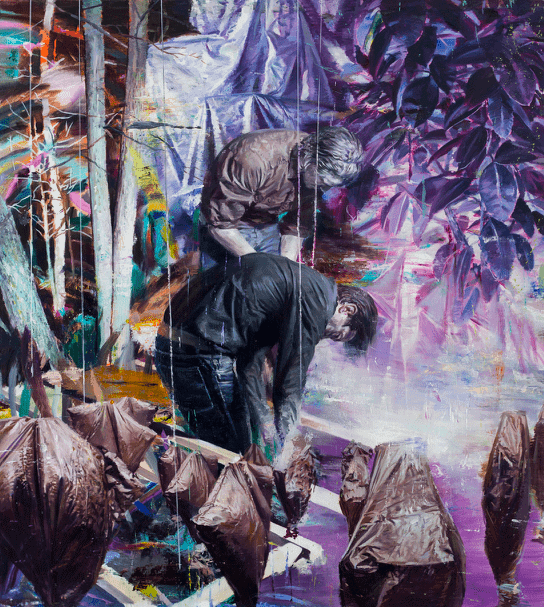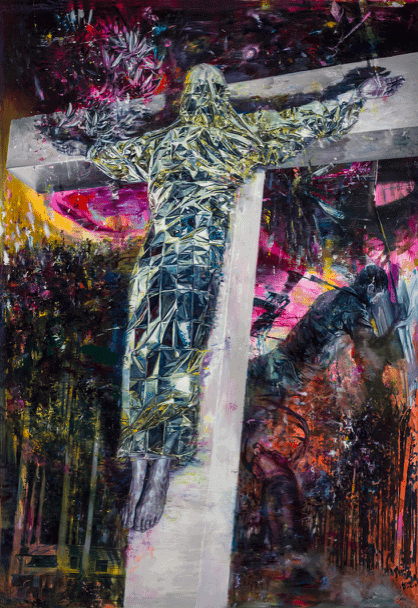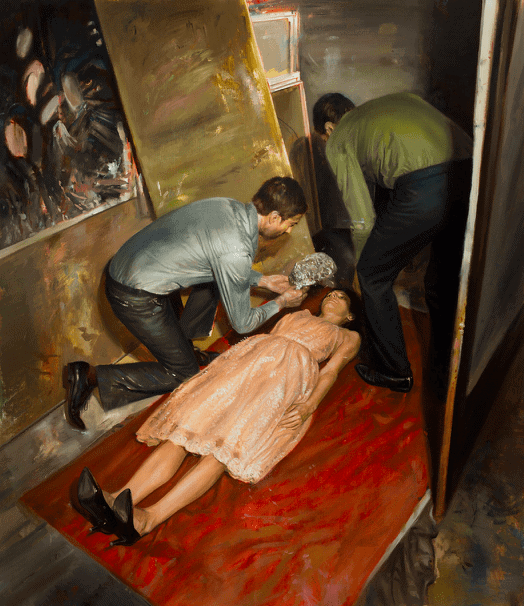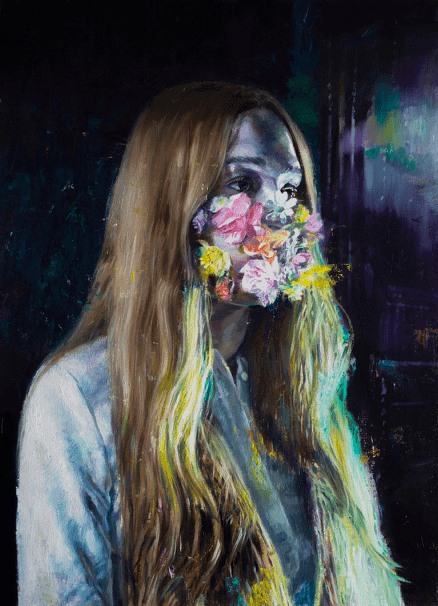
A Conversation With Xuechen Wang
Revolving Narratives: Art, Technology & Human Identity
Remus Grecu (born in 1976 in Bucharest, Romania, currently residing and working in Bucharest, Romania) is a contemporary painter lauded for his distinctive representational visual language marked by vivid colors and surreal and dreamlike compositions. On the occasion of the upcoming solo exhibition titled Night Rainbows at CAI Gallery, we are pleased to present an interview with the Romanian virtuoso on our online CAI platform.
JD
Remus, what a pleasure to have you at our exhibition space CAI Gallery for a solo show and, of course, for this interview as well. Let’s start with the exciting prospect, the upcoming show Night Rainbows. Could you tell us a bit more about this intriguing title and concept?
RG
It’s a notion of what I consider to be dark and yet full of life too; it’s about the monster’s humps that grow inside claustrophobic rooms and flood the viewer’s imagination. I believe in mystery, subconscious power, nightmares, and ‘beautiful crimes.’ Night rainbows are a sum of all of this.
JD
A very strong psychological intensity marks all your paintings. Would you say this is one of your oeuvre’s key aspects, characteristic of your technique, process, and how you ‘serve’ your paintings?
RG
Yes, indeed, to me, this psychological intensity is something I want to achieve with my paintings, alongside strong ideas imbued with a hint of poetry. I want as much as possible to create strong images that often irritate the viewer’s eyes and mind. I wish I could make the subjects of my paintings walk outside the bidimensional layer of the canvas like in a Tarkovskian dream. I work on my paintings for weeks and months to create these images. The psychological intensity can be realized only through many layers of color and hours of work. It’s like building feelings through strokes of colors. The more you work on a painting, the heavier the image becomes. Furthermore, I don’t like light and/or easy images; they are way too easy to make.

JD
Another stand-out quality of many of your works is the immense variety of unique compositions. Could you talk us through the process of how you build or stage these compositions and what elements are of influence and/or importance during this procedure?
RG
The things that inspire me the most are literature and cinema, alongside some of the ‘social happenings’ or daily occurrences. I often get ideas while in a hypnagogic state; I think those are the most creative moments of the brain when you are not awake or asleep. But undoubtedly and alongside some kind of unconscious-like feeling, as I said, I’m also inspired by real things like cinema, literature, etc. I’m a voracious movie enthusiast; I have watched thousands of films and many more to come. I see myself more like a film director than a painter while I build my compositions. Alongside the spontaneity and hand gestures, every element is important in creating a thoughtful image, and so I carefully place my ‘actors’ into the scenic backgrounds. I take photos with people (mainly people close to me), and after, I make them ‘move’ around the scenography till I find the right frame for ‘filming’ it into a single shot future painting.
JD
On the one hand, your paintings are a visual catalyst of wonder; on the other hand, they create an array of questions that often cannot be solved or answered—visual poetry drenched in mystery. To what extent are these questions premeditated, or do they simply go beyond the artist’s intentions?
RG
I’m glad to hear you have observed such things in my work. Even so, I don’t want my images to have that poetic mantra in them. This is still beyond my powers; it just emerges because something inside me is like that. So, I would say the dreamy feeling is in voluntary, but all the rest is carefully picked. I believe a good piece of art has to have a mystery in it and not reveal the whole idea package within it. Even if you create a full idea in a painting, still the technique of realizing it should be abducted by a feeling of mystery. I do not want my viewers to look at my images and find in them the full screenplay Hollywoodian film. I want them to wonder and be lost in my veiled-in-mystery images. Make people curious to understand and desire more and not be lazy while feeding them with art.

JD
An absolute eye-catcher is the monumental painting Ecce Homo. A wrapped crucifixion in a setting that seems to be a forest – with again this ‘colored darkness’ as if the forest is burning during the night. What is the designated purpose and intention of this painting?
RG
Funnily enough, I don’t believe in those fairy tales or biblical stories, but still, the symbol of Jesus Christ is so influential and a part of our collective memory that I couldn’t create something about it. I wanted to find a more contemporary oblation symbol of Christ’s character. And the idea came alongside those disastrous images of burned people wrapped in space blankets that were brought out of this club from Bucharest called ‘Collective.’ If there indeed was a Christ, in a sense, anything and everything comes and goes from a God; therefore, we are all in one. But this large pile of people we call humanity doesn’t go in the right direction, in my opinion. And so here we are, some stupid creatures ‘burning’ themselves more and more with each day. There comes my wrapped-in-a-space blanket, Christ.
JD
We have also included a very strong painting from 2013 titled Soul Thieves. Especially here in Belgium, people tend to link the lying female figure in her pink dress to the iconic Michaël Borremans painting The Angel (2013). However, you made this painting before Borremans exhibited The Angel for the first time in 2014, so there was no direct influence when you made this particular painting. Would you say there are certain similarities between your work and the works by Michaël Borremans?
RG
I don’t think there is a single so-called good contemporary figurative painter today that didn’t pass the Borremans’ influence; if they say it’s not true, I call them liars. Some of them are still struggling today not to be Borremans disciples. I found out about Borremans rather late in comparison to many others. I remember while still living in Stockholm, I saw a poster with Borremans’ show at the Moderna Museum. Only later I came to the conclusion that this poster depicted some of the early works he painted after some old photos. It didn’t impress me at all, and because of that, believe it or not, I didn’t go to the show. Also, obviously, I didn’t know who he was.
I started painting seriously rather late, and at that time, I didn’t know anybody contemporary because I was living far away from the art world. With Soul Thieves, I created that painting because of Tarkovsky’s ‘Solaris’; in a way, I wanted to create something science fiction, but like Tarkovsky, I wanted to create that science fiction happening through a more earthy feeling. Every single painting I make, I try to imagine how Tarkovsky would have painted it if he was a painter and not a genius filmmaker.

JD
Romanian artists have dominated the contemporary art scene since the new millennium; think of Cluj’s thriving contemporary art scene, for instance. However, your career and biography seem to be slightly different compared to many of your compatriots, having lived in London and Stockholm. Now you are back in Bucharest, Romania, and your development and the quality of your work haven’t gone unnoticed in Romania and abroad. Would you say your career has come to a new point of recognition as your name has earned its place in the national and international contemporary art scene?
RG
I was still living in the dream world of northern European fairy tales when the art scene in Romania started to thrive. I come from different experiences than the group from Cluj. I was living like every day was the last day of my life and like a hedonist maniac party monster in London for five years. After those crazy years in London, I had the experience of reconnecting to what is the essence for me, nature, in a peaceful country like Sweden. Finding peace in Stockholm, I started taking painting seriously for the first time in my life. In a way, I always knew I would go back to what I know best, which is to paint. I just needed around fifteen years to wonder about the rainbow of feelings of a destructive and positive world, to be later able to paint my nightmares.
And so my first studio was in a dark little room in Stockholm, where I was with my north European forest trolls and monsters every night, also because I paint at night time. I am the mixture of a child growing up in a communist country where strong colors were non-existent, with the spice of London madness and the peaceful darkness of northern Europe forests. After all, I’m not in a hurry; some have it quick into stardom, and others need to mature first to get up there. I have no doubts that my name someday will stand up there, mainly because I know ‘my trade.’

JD
2020 and 2021 were dominated by the ubiquitous Covid-19 virus. How did you experience the pandemic, and did it have an impact on your artistic practice?
RG
Actually, this Covid thing has not changed my life that much. I am a loner anyway; society doesn’t interest me that much, with or without covid. I sleep mainly when everyone is awake, and I am awake when the world sleeps. I liked it better, though, when those first quarantines were imposed, empty doomsday-like streets; it was perfect for wandering illegally on the streets of Bucharest at night time. The only things that I missed were the parties and the girls. But there’s always another option to have fun; even in times of war, love continues. And so, there I had my way through the covid times.
JD
The painting Veiled Mistakes (2020) seems to be a direct comment on the pandemic. The chosen title makes things even more interesting.
RG
Yes, also, in a sick world, there are great ideas to be found too. It took me a while to find a symbol for what we have been living for over a year. I still like that painting because, in a way, even though it represents the stupidity of our insatiable humanity, it has a happy perfume twist in it as well.
JD
And so it is another Night Rainbow. I am really looking forward to the exhibition. Thank you for the great interview, Remus. It’s been a pleasure, as always!
RG
Thank you for having me!
Last Updated on July 5, 2024

Revolving Narratives: Art, Technology & Human Identity

White Cube, Seoul, KR

(b. 1998)